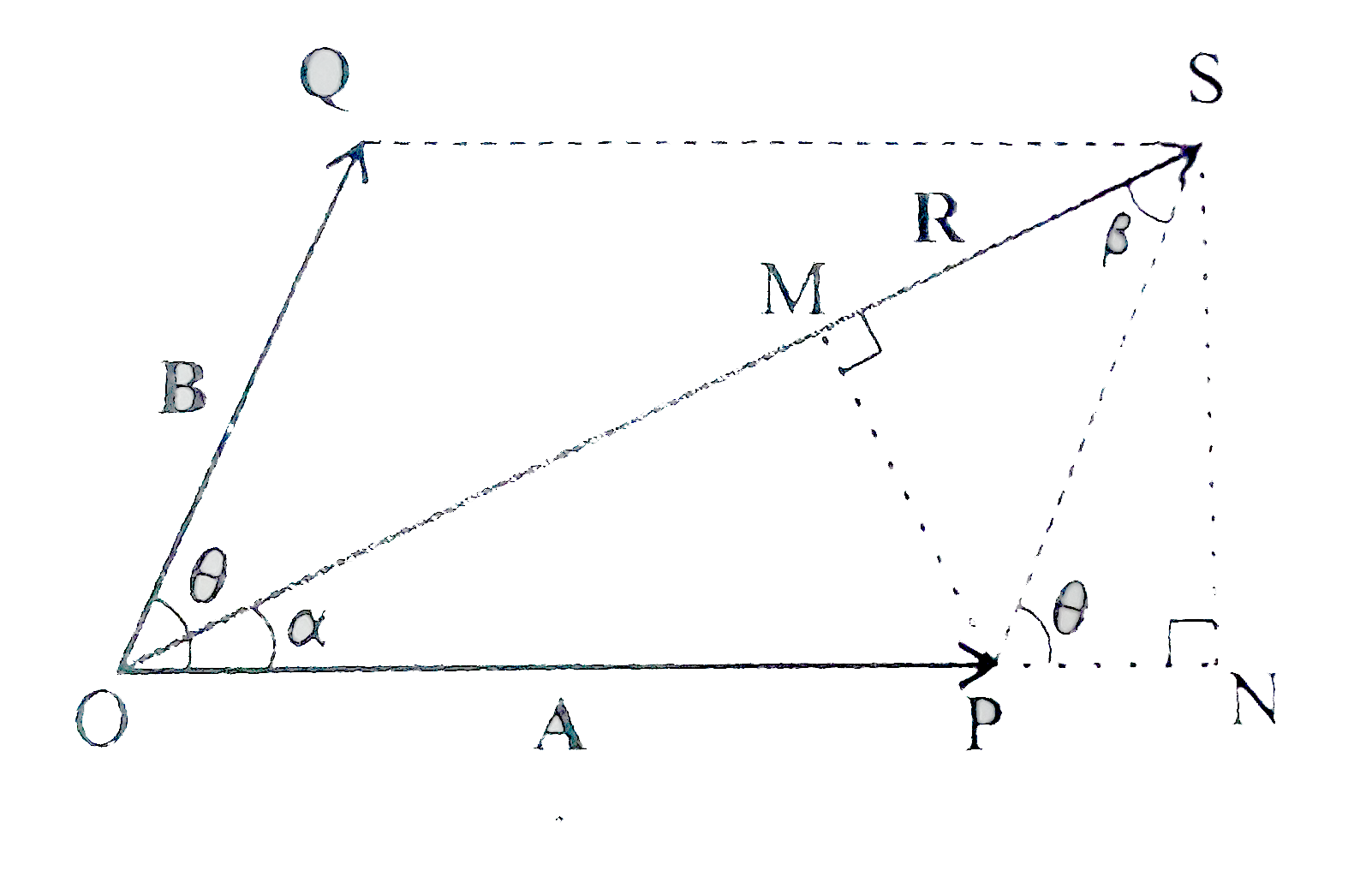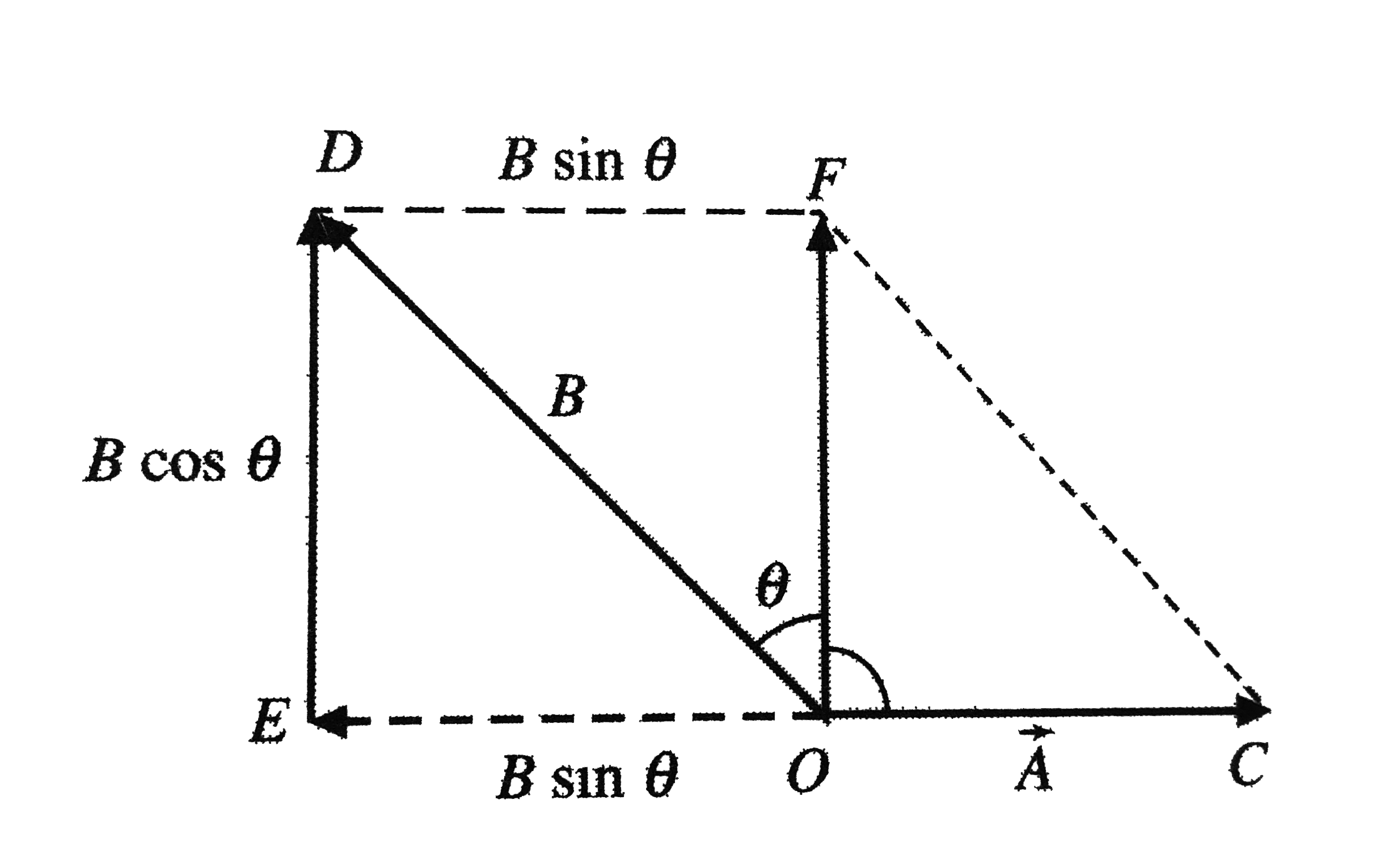The resultant of two vector A and B is at right angles to A and its magnitude is half of B. Find the angle between A and B.
The correct Answer is:A
To solve the problem, we need to find the angle between two vectors A and B, given that their resultant is perpendicular to vector A and has a magnitude that is half of vector B.
1. Understanding the Problem:
We have two vectors A and B. The resultant vector R = A + B is at a right angle (90 degrees) to vector A. We also know that the magnitude of the resultant vector R is half the magnitude of vector B.
2. Setting Up the Vectors:
Let's denote the angle between vectors A and B as θ. We can use the cosine and sine components of vector B with respect to vector A:
- The horizontal component of B (along A) is Bcos(θ).
- The vertical component of B (perpendicular to A) is Bsin(θ).
3. Finding the Resultant:
Since the resultant R is perpendicular to A, we can express the resultant in terms of its components:
- The component of R along A is A+Bcos(θ) (which must equal 0 since R is perpendicular to A).
- The vertical component of R is Bsin(θ).
4. Setting Up the Equations:
From the above, we have:
A+Bcos(θ)=0(1)
This implies:
A=−Bcos(θ)(2)
5. Magnitude of the Resultant:
The magnitude of the resultant R is given as:
|R|=√(A+Bcos(θ))2+(Bsin(θ))2
Since |R|=12|B|, we can write:
|R|=√0+(Bsin(θ))2=Bsin(θ)
Therefore, we have:
Bsin(θ)=12B
This simplifies to:
sin(θ)=12(3)
6. Finding the Angle θ:
From equation (3), we know that:
θ=30∘orθ=150∘
7. Finding the Angle Between A and B:
Since we are looking for the angle between A and B, and we know that the angle between A and the resultant is 90 degrees, we can find the angle between A and B:
Angle between A and B=90∘+θ
Thus:
Angle between A and B=90∘+60∘=150∘
Final Answer:
The angle between vectors A and B is 150 degrees.
We have two vectors A and B. The resultant vector R = A + B is at a right angle (90 degrees) to vector A. We also know that the magnitude of the resultant vector R is half the magnitude of vector B.
Let's denote the angle between vectors A and B as θ. We can use the cosine and sine components of vector B with respect to vector A:
- The horizontal component of B (along A) is Bcos(θ).
- The vertical component of B (perpendicular to A) is Bsin(θ).
Since the resultant R is perpendicular to A, we can express the resultant in terms of its components:
- The component of R along A is A+Bcos(θ) (which must equal 0 since R is perpendicular to A).
- The vertical component of R is Bsin(θ).
From the above, we have:
A+Bcos(θ)=0(1)
This implies:
A=−Bcos(θ)(2)
The magnitude of the resultant R is given as:
|R|=√(A+Bcos(θ))2+(Bsin(θ))2
Since |R|=12|B|, we can write:
|R|=√0+(Bsin(θ))2=Bsin(θ)
Therefore, we have:
Bsin(θ)=12B
This simplifies to:
sin(θ)=12(3)
From equation (3), we know that:
θ=30∘orθ=150∘
Since we are looking for the angle between A and B, and we know that the angle between A and the resultant is 90 degrees, we can find the angle between A and B:
Angle between A and B=90∘+θ
Thus:
Angle between A and B=90∘+60∘=150∘
The angle between vectors A and B is 150 degrees.
Topper's Solved these Questions
- VECTORSBOOK - DC PANDEY ENGLISHCHAPTER - VECTORSEXERCISE - Example
40 Videos
- VECTORSBOOK - DC PANDEY ENGLISHCHAPTER - VECTORSEXERCISE - check point 2.1
15 Videos
- VECTORSBOOK - DC PANDEY ENGLISHCHAPTER - VECTORSEXERCISE - Single Correct
39 Videos
- UNITS, DIMENSIONS & ERROR ANALYSIS BOOK - DC PANDEY ENGLISHCHAPTER - UNITS, DIMENSIONS & ERROR ANALYSIS EXERCISE - Medical entrances gallery
32 Videos
- WAVE MOTIONBOOK - DC PANDEY ENGLISHCHAPTER - WAVE MOTIONEXERCISE - Integer Type Question
11 Videos
Similar Questions
The sum of two vectors A and B is at right angles to their difference. Then
View SolutionThe sum of two vectors A and B is at right angles to their difference. Then
View SolutionThe sum of two vectors A and B is at right angles to their difference. Then
View SolutionThe resultant of two vectors A and B is perpendicular to the vector A and its magnitude is equal to half the magnitude of vector B. The angle between A and B is -

View SolutionFind the magnitude and direction of the resultant of two vectors A and B in the terms of their magnitudes and angle θ between them.

View SolutionThe resultant of two vectors →A and →B is perpendicular to the vector →A and its magnitude is equal to half of the magnitude of the vector →B. Find out the angles between →A and →B.
 .
.
View SolutionMagnitude of resultant of two vectors →P and →Q is equal to magnitude of →P . Find the angle between →Q and resultant of →2P and →Q .
View SolutionThe resultant of two vectors →A and →B is perpendicular to the vector →A and its magnitudes is equal to half of the magnitudes of vector →B (figure). The angle between →A and →B is

View SolutionTwo vectors →Aand→B are at right angles to each other then
View SolutionIf magnitude of the resultant of two vectors equal of magnitude, is equal to the magnitude of either of the vectors, what is the angle between them ?
View Solution
